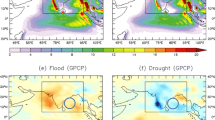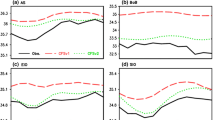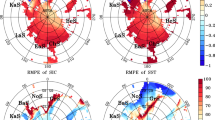Abstract
In this study role of upper ocean processes in the evolution of sea surface temperature (SST) seasonal variations over the tropical Indian Ocean (TIO) is investigated in climate forecast system version1 (CFSv1) and version2 (CFSv2). Analysis reveals that CFSv2 could capture seasonal evolution of SST, wind speed and mixed layer depth better than CFSv1 with some biases. Discrepancy in reproducing the evolution of seasonal SST in coupled models leads to bias in the spatial and temporal distribution of precipitation. This has motivated to carry out mixed layer heat budget analysis in determining seasonal evolution of TIO SST. Spatial pattern of mixed layer heat budget from observations and models suggest that the processes responsible for SST tendency differ from region to region over the TIO. Further it is found that models underestimated SST tendency compared to the observations. Misrepresentation of advective processes and heat flux (HF) over the TIO is mainly responsible for the distortion of seasonal SST change in the coupled models. Sub-regional heat budget analysis reveals that CFSv1 is unable to reproduce the annual cycle of mixed layer temperature (MLT) tendency over the Arabian Sea, while CFSv2 captured the annual cycle of SST with systematic cold bias. Misrepresentation of the annual cycles of net HF and horizontal advection (Hadv) are accountable for the low rate of change of MLT during most of the year. Hadv during summer season is underestimated by 50 and 25 % respectively in CFSv1 and CFSv2. Further, CFSv1 fails to simulate MLT tendency due to improper evolution of HF annual cycle over the Bay of Bengal. Though annual cycle of HF in CFSv2 is well represented over the Bay of Bengal, its contribution to MLT change is underestimated compared to observations. Over the southern TIO region, MLT tendency is dominated by HF and Hadv terms in both observations and models. Contribution of HF to the annual cycle of MLT tendency is underestimated in CFSv1 whereas it is overestimated in CFSv2. Contribution of Hadv to MLT change is underestimated by about 50 % in CFSv1 and 10–20 % in CFSv2 over southern TIO. These errors in HF and Hadv are associated with biases in HF components and surface wind representation. Evolution of lead–lag relationship between HF and MLT/SST in both the observations and models suggest the importance of HF in SST evolution over the TIO region. Over all, CFSv2 produced better SST seasonal/annual cycle in spite of having cold bias. This improvement in CFSv2 may be attributed to better cloud–aerosol–radiation physics, which reduces radiation biases. Updated land-surface, ocean and sea ice processes and ocean component may be responsible for improved circulation and annual cycle of ocean–atmospheric components (winds and ocean circulation). However, there is a requirement for improved parameterization of turbulent HF and radiation estimates in CFSv2 to reduce the cold SST bias.











Similar content being viewed by others
References
Annamalai H (2010) Moist dynamical linkage between the equatorial Indian Ocean and the south Asian monsoon trough. J Atmos Sci 67:589–610
Behera SK, Luo J-J, Masson S, Delecluse P, Gualdi S, Navarra A, Yamagata T (2005) Paramount impact of the Indian Ocean Dipole on the East African short rains: a CGCM study. J Clim 18:4514–4530
Bollasina MA, Ming Y (2013) The general circulation model precipitation bias over the southwestern equatorial Indian Ocean and its implications for simulating the South Asian monsoon. Clim Dyn 40:823–838
Boschat G, Terray P, Masson S (2012) Robustness of SST teleconnections and precursory patterns associated with the Indian summer monsoon. Clim Dyn 38:2143–2165
Carton JA, Giese BS (2008) A reanalysis of ocean climate using Simple Ocean Data Assimilation (SODA). Mon Weather Rev 136:2999–3017
Chaudhari HS, Pokhrel S, Saha SK, Ashish D, Yadav RK, Salunke K, Mahapatra S, Sabeerali CT, Rao SA (2013) Model biases in long coupled runs of NCEP CFS in the context of Indian Summer Monsoon. Int J Climatol 33:1057–1069. doi:10.1002/joc.3489
Chowdary JS, Chaudhari HS, Gnanaseelan C, Parekh A, Rao SA, Sreenivas P, Pokhrel S, Singh P (2014) Summer monsoon circulation and precipitation over the tropical Indian Ocean during ENSO in the NCEP climate forecast system. Clim Dyn 42:1925–1947. doi:10.1007/s00382-013-1826-5
Clark CO, Cole JE, Webster PJ (2000) Indian Ocean SST and Indian summer rainfall: predictive relationships and their decadal variability. J Clim 13:2503–2519
Clough SA, Shephard MW, Mlawer EJ, Delamere JS, Iacono MJ, Cady-Pereira K, Boukabara S, Brown PD (2005) Atmospheric radiative transfer modeling: a summary of the AER codes. J Quant Spectrosc Radiat Transf 91:233–244
de Boyer Montegut C, Mignot CJ, Lazar A, Cravatte S (2007) Control of salinity on the mixed layer depth in the world ocean: 1. General description. J Geophys Res 112:C06011. doi:10.1029/2006JC003953
Du Y, Qu T, Meyers G, Masumoto Y, Sasaki H (2005) Seasonal heat budget in the mixed layer of the southeastern tropical Indian Ocean in a high-resolution ocean general circulation model. J Geophys Res 110:C04012. doi:10.1029/2004JC002845
Ek MB, Mitchell KE, Lin Y, Rogers E, Grunmann P, Koren V, Gayno G, Tarplay JD (2003) Implementation of Noah land surface model advances in the National Centers for Environmental Prediction operational mesoscale Eta model. J Geophys Res 108(D22):8851. doi:10.1029/2002JD003296
Griffies S, Harrison MJ, Pacanowski RC, Anthony R (2004) A technical guide to MOM4, GFDL ocean group technical report no. 5. NOAA/Geophysical Fluid Dynamics Laboratory, Princeton, 342 pp
Hogg AM, Meredith MP, Blundell JR, Wilson C (2008) Eddy heat flux in the Southern Ocean: Response to variable wind forcing. J Clim 21:608–620
Iacono MJ, Mlawer EJ, Clough SA, Morcrette J-J (2000) Impact of an improved longwave radiation model, RRTM, on the energy budget and thermodynamic properties of the NCAR community climate model, CCM3. J Geophys Res 105:14873–14890
Izumo T, Montégut CD, Luo J-J, Behera SK, Masson S, Yamagata T (2008) The role of the western Arabian Sea upwelling in Indian monsoon rainfall variability. J Clim 21:5603
Kara AB, Rochford PA, Hurlburt HE (2003) Mixed layer depth variability over the global ocean. J Geophys Res. doi:10.1029/2000JC000736
Krishna Kumar K, Hoerling M, Rajagopalan B (2005) Advancing dynamical prediction of Indian Monsoon Rainfall. Geophys Res Lett 32:L08704. doi:10.1029/2004GL021979
Lee JY, Wang B, Kang IS, Shukla J et al (2010) How are seasonal prediction skills related to models’ performance on mean state and annual cycle? Clim Dyn 35:267–283
Levine RC, Turner AG, Marathayil D, Martin GM (2013) The role of northern AS surface temperature biases in CMIP5 model simulations and future projections of Indian summer monsoon rainfall. Clim Dyn 41:155–172. doi:10.1007/s00382-012-1656-x
Locarnini RA, Mishonov AV, Antonov JI, Boyer TP, Garcia HE, Baranova OK, Zweng MM, Johnson DR (2010) World Ocean Atlas 2009, volume 1: temperature. S. Levitus, Ed. NOAA Atlas NESDIS 68, U.S. Government Printing Office, Washington, DC, 184 pp
Marathayil D, Turner AG, Shaffrey LC, Levine RC (2013) Systematic winter sea-surface temperature biases in the northern Arabian Sea in HiGEM and the CMIP3 models. Environ Res Lett 8:014028
McCreary JP, Kundu PK, Molinari RL (1993) A numerical investigation of the dynamics, thermodynamics and mixed layer processes in the Indian Ocean. Prog Oceanogr 31:181–244
Moorthi S, Pan HL, Caplan P (2001) Changes to the 2001 NCEP operational MRF/AVN global analysis/forecast system. NWS Tech Proced Bull 484:14
Pacanowski RC, Griffies SM (1999) MOM 3.0 manual NOAA/Geophysical Fluid Dynamics Laboratory Rep, 680 pp
Perigaud C, Delecluse P (1992) Annual sea-level variations in the tropical Indian Ocean from Geosat and shallow-water simulations. J Geophys Res 27:20169–20179
Pokhrel S, Rahaman H, Parekh A, Saha SK, Dhakate A, Chaudhari HS, Gairola RM (2012) Evaporation–precipitation variability over Indian Ocean and its assessment in NCEP climate forecast system (CFSv2). Clim Dyn 39:2585–2608
Praveen Kumar B, Vialard J, Lengaigne M, Murty VSN, McPhaden MJ (2010) TropFlux: air-sea fluxes for the global tropical oceans–description and evaluation against observations. Clim Dyn 38:1521–1543
Prodhomme C, Masson S, Terray P, Izumo T, Tozuka T, Yamagata T (2012) Impacts of Indian Ocean SST biases on the Indo-Pacific climate as simulated in a global coupled model. Geophysical Research Abstracts 14, EGU2012-10020-1, EGU General Assembly 2012
Prodhomme C, Terray P, Masson S, Izumo T, Tozuka T, Yamagata T (2014) Impacts of Indian Ocean SST biases on the Indian Monsoon: as simulated in a global coupled model. Clim Dyn 42:271–290. doi:10.1007/s00382-013-1671-6
Qiu B (2000) Interannual variability of the Kuroshio extension system and its impact on the wintertime SST field. J Phys Oceanogr 30:1486–1502
Qu T (2003) Mixed layer heat balance in the western North Pacific. J Geophys Res 108(C7):3242. doi:10.1029/2002JC001536
Saha S, Nadiga S, Thiaw C, Wang J, Wang W, Zhang Q, van den Dool HM, Pan HL, Moorthi S, Behringer D, Stokes D, White G, Lord S, Ebisuzaki W, Peng P, Xie P (2006) The NCEP climate forecast system. J Clim 15:3483–3517
Saha S, Moorthi S, Wu X, Wang J, Nadiga S, Tripp P, Pan HL, Behringer D, Hou Y-T, Chuang H-Y, Mark I, Michael E, Meng J, Yang R (2014) The NCEP climate forecast system version 2. J Clim 27:2185–2208. doi:10.1175/JCLI-D-12-00823.1
Saha Subodh K, Pokhrel S, Chaudhari HS, Dhakate A, Shewale S, Sabeerali CT, Salunke K, Hazra A, Mahapatra S, Rao AS (2014) Improved simulation of Indian summer monsoon in latest NCEP climate forecast system free run. Int J Climatol 34:1628–1641. doi:10.1002/joc.3791
Sahai AK, Sharmila S, Abhilash S, Chattopadhyay R, Borah N, Krishna RPM, Joseph S, Roxy M, De S, Pattnaik S, Pillai PA (2013) Simulation and extended range prediction of monsoon intraseasonal oscillations in NCEP CFS/GFS version 2 framework. Curr Sci 104(10):1394–1408
Schott FA, Xie S-P, McCreary JP (2009) Indian Ocean circulation and climate variability. Rev Geophys 47:RG1002. doi:10.1029/2007RG000245
Shankar D, Vinayachandran PN, Unnikrishnan AS, Shetye SR (2002) The monsoon currents in the north Indian Ocean. Prog Oceanogr 52:63–119
Taschetto AS, Gupta AS, Hendon HH, Ummenhofer CC, England MH (2011) The relative contribution of Indian Ocean sea surface temperature anomalies on Australian summer rainfall during El Niño events. J Clim 24:3734–3747
Turner AG, Joshi M, Robertson ES, Woolnough SJ (2012) The effect of Arabian Sea optical properties on SST biases and the South Asian summer monsoon in a coupled GCM. Clim Dyn 39(3–4):811–826. doi:10.1007/s00382-011-1254-3
Wang B, Kang I-S, Lee J-Y (2004) Ensemble simulations of Asian-Australian monsoon variability by 11 AGCMs. J Clim 17:803–818
Wang B, Lee J-Y, Kang I-S, Shukla J, Kug J-S, Kumar A, Schemm J, Luo J-J, Yamagata T, Park C-K (2008) How accurately do coupled climate models predict the Asian-Australian monsoon interannual variability? Clim Dyn 30:605–619
Wang B, Lee JY, Kang IS, Shukla J (2009) Advance and prospect of seasonal prediction: assessment of the APCC/CliPAS 14-model ensemble retroperspective seasonal prediction (1980–2004). Clim Dyn 33:93–117. doi:10.1007/s00382-008-0460-0
Wu R, Kirtman BP (2007) Regimes of seasonal air–sea interaction and implications for performance of forced simulations. Clim Dyn 29:393–410. doi:10.1007/s00382-007-0246-9
Wu X, Moorthi KS, Okomoto K, Pan HL (2005) Sea ice impacts on GFS forecasts at high latitudes. Preprints, Eighth Conference on Polar Meteorology and Oceanography, San Diego, CA, Amer. Meteor. Soc., 7.4. http://ams.confex.com/ams/pdfpapers/84292.pdf
Xie P, Arkin PA (1996) Analyses of global monthly precipitation using gauge observations, satellite estimates and numerical model predictions. J Clim 9:840–858
Xie S-P, Hu K, Hafner J, Du Y, Huang G, Tokinaga H (2009) Indian Ocean capacitor effect on Indo-western Pacific climate during the summer following El Niño. J Clim 22:730–747
Yang J, Liu Q, Xie S-P, Liu Z, Wu L (2007) Impact of the Indian Ocean SST basin mode on the Asian summer monsoon. Geophys Res Lett 34:L02708. doi:10.1029/2006GL028571
Yoo S-H, Yang S, Ho C-H (2006) Variability of the Indian Ocean sea surface temperature and its impacts on Asian-Australian monsoon climate. J Geophys Res 111:D03108. doi:10.1029/2005JD006001
Zheng Y, Shinoda T, Lin J-L, Kiladis GN (2011) Sea surface temperature biases under the stratus cloud deck in the Southeast Pacific Ocean in 19 IPCC AR4 coupled general circulation models. J Clim 24:4139–4164
Acknowledgments
We thank Director IITM for support. Sayantani acknowledge the support of Council of Scientific and Industrial Research (CSIR), India for Junior Research Fellowship. We sincerely thank anonymous reviewers for their valuable comments that helped us to improve the manuscript. We wish to thank H. S. Chaudhari, S. K. Saha and S. Pokhrel for providing model data. Figures are prepared using GrADS.
Author information
Authors and Affiliations
Corresponding author
Rights and permissions
About this article
Cite this article
Chowdary, J.S., Parekh, A., Ojha, S. et al. Role of upper ocean processes in the seasonal SST evolution over tropical Indian Ocean in climate forecasting system. Clim Dyn 45, 2387–2405 (2015). https://doi.org/10.1007/s00382-015-2478-4
Received:
Accepted:
Published:
Issue Date:
DOI: https://doi.org/10.1007/s00382-015-2478-4




